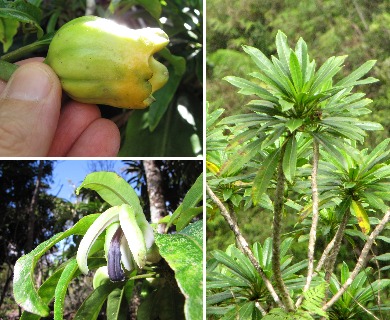`Oha Wai Nui
Clermontia arborescens
Harebell family (Campanulaceae)
Native species ()
Clermontia is a distinctive of about 21 species of shrubs and small trees confined to Hawaii. Several are classed as rare. Only a few species reach tree size, and one example will serve for recognition of the group. These plants have few branches, like candelabras, and milky sap. They bear many long narrow leaves at the ends of stout branches. The few large flowers borne on stalks at leaf bases have an curved tubular deeply split to base, varying from green to white or yellowish to purplish. The are large yellow or orange berries 1 inch (2.5 ) or more in diameter, edible but insipid.

©2011 Forest And Kim Starr
Leaves many, but crowded together near ends of branches, large, spreading on slender leaf-stalks of 1 1⁄4–2 1⁄2 inches (3–6 ). Blades oblong, 5–7 inches (12–18 ) long and 2 1⁄4–2 inches (3–5 ) wide, often slightly long-pointed at both ends, wavy on edges, thick and leathery, shiny dark green above, pale beneath.
Flowers 1–2 at leaf base on stalks of about 1 inch (2.5 ) from fleshy stalk of about 3⁄8 inch (1 ), 2 1⁄2–3 1⁄4 inches (6–8 ) long, large and fleshy, hairless, consisting of bell-shaped base () 3⁄4 inch (2 ) long ending in fleshy of five short blunt fleshy 2–2 3⁄4 inches (5–7 ) long, greenish or whitish with reddish purple tinge, and much curved, deeply five- and deeply split to base; five, separate from purplish or violet, in column 2 1⁄2 inches (6 ) long, united by the long and with inferior two-celled numerous ovules, and long
() rounded, 1–1 1⁄2 inches (2.5–4 ) in diameter, yellow, with five long ridges and grooves, and with at two-celled. Seeds, many, about 1⁄32 inch (1 ) long, rounded but flattened, shiny yellow or brown.
The yellow berries are sometimes eaten by birds and humans.
One of the most common species of the in the understory of wet forests at 1700–6000 ft (518–1829 ) elevation.
Range
Molokai, Lanai, and Maui
Other common names
‘oha, tree clermontia






